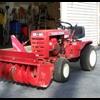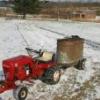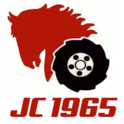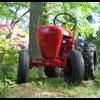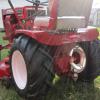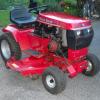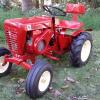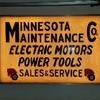Leaderboard
-
in Posts
- All areas
- Markers
- Marker Comments
- Marker Reviews
- Articles
- Article Comments
- Article Reviews
- Classfieds
- Classified Comments
- Classified Reviews
- Wiki's
- Wiki Comments
- Wiki Reviews
- Blog Entries
- Blog Comments
- Images
- Image Comments
- Image Reviews
- Albums
- Album Comments
- Album Reviews
- Files
- File Comments
- File Reviews
- Posts
-
Custom Date
-
All time
November 28 2011 - November 28 2025
-
Year
November 28 2024 - November 28 2025
-
Month
October 28 2025 - November 28 2025
-
Week
November 21 2025 - November 28 2025
-
Today
November 28 2025
-
Custom Date
10/25/2016 - 10/25/2016
-
All time
Popular Content
Showing content with the highest reputation on 10/25/2016 in Posts
-
12 pointsFound some ag tires and rims at a old gas tractor show. I blasted and painted the rims and mounted them on this little guy. I kinda like the look. I'm gonna need a new place to house it though because she will no longer fit through the shed door.
-
11 points
-
6 pointsSaw this at a new job today. It needs a hug... I may end up trying to buy it before I leave... I think I saw a deck in the weeds, and possibly a rear blade.
-
6 pointsGuys, I finally was fortunate enough to meet and spend time with19Richie66. He is an all around terrific guy and I encourage everyone here to introduce yourselves to him at the Big Show next year if you have not already met him. Richie is hoping to attend his first Big Show, and I sure hope he can make it happen. We did some horse trading and with the help of Richie's Son, hauled stuff off of Richie's trailer and into my shop and Wheel Horse rolling chassis storage building. Then hauled stuff out of my storage building and Wheel Horse Barn and into his trailer. Richie ended up with a complete rear end and hydro pump and tach and vacuum gauge from a 520H roller I had. Also my old 417Hydro rolling chassis that was in the storage building, and the KT17 series 2 engine that was being stored in the Wheel Horse barn. And maybe some other stuff that I can't remember at this time. I happily ended up with a 1989 312-8 that has a fine running Magnum 12. The tractor needs a fender pan, seat, clutch return spring, and some TLC to be a usable working tractor. Buts that's no problem as I should have everything needed right here in stock. The tractor came with a set of Firestone AG's which I've already removed to put on John Robert (my K powered 416-8). The bonus to this 312-8 is it has a stack exhaust complete with a rain cap. Next cool thing I got from Richie was a complete running 10hp K engine mounted on a shaker plate. This engine has a little stack muffler with a rain cap that I may put on the 701. That should make it look even more like a miniature farm tractor. I have a Blackhood roller that needs a shaker plate engine. Then a complete but at the present time nonworking 8 speed transmission that can be repaired or used for parts. We had to part company much too soon, but Richie had to get back home to Florida. Here is a few pics of the things I ended up with.
-
5 pointsFirst time I have had the stable out for some exercise and a photo shoot.They may not be to pretty but they sure work hard. Hope this satisfies the cries for more pictures.JAinVA
-
5 pointsWell, I made enough progress to warrant a few pic. I cut the bends off the 105 rocker plate to make a solid engine mounting plate for the 321. I had to shim the plate up 1/2" to get the dropped pan to clear the steering rod extension tube. Got the steering geometry worked out and the engine installed. And got some painting finished. Still have to work out the clutch and throttle linkage. and a lot of body work on the hood and seat/fender pan. Got the snow movers ready and snapped a pic for size reference.
-
5 points
-
5 points1980-1984 C-165 Automatic and C-145 Automatic are the only tractors that fit those specific requirements. However, if you are willing to look at the Kohler Magnums which were essentially the same as a K series but had a magneto ignition. That opens up your scope to include 1990 and newer 312-H and 314-H but some feel these engines are a BIT under powered running a Hydro with a big mower deck or snow blower. Also there are koher twins if you dont want to go Onan, like the C-175 Auto, 417-A, 418-A, 418-C. But in reality, the Onans are just fine for many people (and lots of people LOVE them!) They sound really cool, are VERY smooth running and have quite a bit of power. That will expand your search to all the newer 416-H's and 520-H's as well (of which there are very many of these around!) I don't know if you have a specific reason to be going hydro, but most attachments are not unreasonable to use a hand-lift with (and some are even preferred, like mid-mount grader blade). The 8 speeds are just about bullet proof and for ground engaging work cant be beat. The hydros are smoother for cutting grass and (for me) plowing snow especially when converted to foot pedal control. That will expand your search immensely!
-
5 pointsI don't know what kind of cast iron the Kohlers on those old 953's are made of but 953Nut recently brought one home that looked like it had been salvaged from the bottom of the Atlantic Ocean. He put a battery and gas in it and the thing started right up! Amazing
-
4 pointsThere are 2 bolts in the top of the trans that hold the lift cable tube on. Take one of those out and it will vent there.
-
4 pointsSundstrands all very durable and garden tractor manufacturers started using them over 50 years ago. Most are still in original condition. They are very strong units. The Magnums were starting to be phased out in the late 80s and early 90s. Most manufacturers have already started using the Kohler Command by that time. Toro was a bit behind in putting the Commands in their tractors. Nothing wrong with either the Magnum or the Command as both are Kohler's commercial grade engines. Onan is also a commercial grade engine and are built to last. Parts, though are a bit pricey.
-
4 pointsThe brake will slow it down but all of mine will turn if nothing is attached. It will stop when you attach the deck
-
3 pointsFuses are a good thing, lots of older didn't have them and should have. Presuming you have a battery ignition system with points and a coil the following simple diagram should be helpful. The wire sizes are not Gospel, if you want to use a larger size (smaller number wire gauge) that is fine. The second and third are for reference for other systems.
-
3 points
-
3 pointsYes it was very nice to meet finally. You are a good man! Always nice to put a face with a name. Too bad I could only stay so long. I would have talked tractors and stuff all day. Glad you got the 312 fired up and was satisfied with it. I hope to get the 417 washed down and put back together here soon. As for the firewater, I didn't get to witness it's existence but did hear tales of it's power. Maybe I will witness that next year. The boom sprayer sounds like a good idea. Here is a picture of my load going home. Who says the beverly hillbillies are dead?
-
3 pointsAt least in my environment, near the Canadian border, both blade AND blower are required for snow removal! Blade will handle light storms and blade will cleanup after the blower moves the heavy snows. Point is that I most always use the blade for final cleanup! Wouldn't be without it! Otherwise the little bit that the blower leaves builds up, partially melts and refreezes and later turns into ice and causes me to fall and brake my ankle... really! So up here I like to try to scrape the drive clean and hope some sun comes through to "burn" off the remainder so I can start with a completely bare driveway again! I'm so serious about this (broken ankle!) that I also intend to add a Sweepster! But blower and blade is a very nice combo until then! Thanks for sharing!
-
2 pointsPicked up this 58 RJ today! It has the shower head and the original heat shield and reel mower belt guard. Came with a deck, a tub cart, and a snowplow. Will get better pics later!
-
2 pointsI mounted this loader on one of my 520H's, it's a Sears Smipson made in Canada. They are a very good loader. I will post more pics later on how I hooked it up. The rims are altered , made extra wide.
-
2 points
-
2 points
-
2 pointsThanks ACman, I'm glad to have helped get you started into a great hobby. My shop also serves as my hideout, my get away. I get a lot of satisfaction out of being able to do so many different things right here at home. It's also pretty amazing what a guy can teach himself to do with the right tools at hand. Maybe I will posts in the new thread one day with a few pics of the shop.
-
2 points
-
2 pointsWhile I am glad to see a C-105 Black Hood gave it's life for a fellow WH, very typical of the breed I might add, my C-105 grieves for it's lost cousin... VERY nice build, by the way...
-
2 points
-
2 points
-
2 points
-
2 pointsHeh Guys -- Be careful with the HCl (hydrochloric acid) -- Besides being corrosive/burning, HCl like all of those other acids is generating hydrogen gas (which is explosive in the presence of an ignition source) when they remove the rust -- With the slow rust removal (i.e. vinegar, phosphoric acid) the hydrogen is getting time to disperse into the air -- With the HCl and a closed up tank you could build up a significant amount of gas which would explode with a spark/fire (i.e. you are making a bomb) -- So the biggest watch out would be to use the HCl in the absence of ignition sources and vent the tank often (or don't close the tank) when using HCl
-
2 pointsAny engine, old or new, can backfire if not properly idled down for a minute or so after hard use. I get on my wife and kids for that all the time.
-
2 pointsSince this is turning into a study of tractors, I thought that I would add a few things. I have never owned a Sundstrand (yet!) but have a few Hydro tractors. Eaton only manufactured the transmission which was then installed on the three different transaxles made by Wheel Horse/Toro. Tractors with an -A (but not all) normally used the 700 series transaxle with a manual lift. Onan and Kohler engines were used. Tractors with a -H did use the 1100 series transaxle with hydraulic lift capability. Onan and Kohler engines were used. These can be plumbed to eliminate the lift if necessary. It would be best to take a chassis with a manual lift and install the 1100 if a manual lift was desired. The 5xi series all used the Eaton 11 with a re-designed 1100 transaxle. Kohler, Kawasaki, and Daihatsu engines were used. This transaxle added Hi/Lo gears as well as a neutral position along with hydraulic lift and hydraulic power steering on three of the five models. Regarding the 520-H gathering grass clippings while mowing, my 523Dxi with the water-cooled Daihatsu diesel does the same thing. But there are the three screens below the dash plus a removable fine mesh screen (last photo) in front of the radiator. My Kohler-engined 5xi don't have the same problem due to moving less air for cooling.
-
2 pointsI'm curious as to why you think this is a problem? On these tractors the hydro is not like a pressure washer, when you are idling in neutral they are running the fluid through the hoses and filter at a fairly low pressure (30-90psi). The fan keeps the motor/pump cool and everything is just circulating unimpeded. They are designed to work or idle all day long, so you should be good to go, don't worry about letting a hydrostat idle.
-
2 pointsI had quite a collection of different models, over 30, and started selling them a year or so ago. I sold most of what I had collected except a couple RL's, a couple suburban's, c-120, 520-H, 856 and a 418-A. Know I have my complete workshop back and don't have to move anything to work on a project. I miss some of them, but it sure is nice to work on something without doing a bunch of extra work to get at a tool.
-
2 pointsGot the power washer together this weekend and was able to clean up the 520h moderately. Can definitely see the engine and frame better. Was able to get a better look at the engine. Unfortunately when I was taking off the RH side shroud the bolts were brittle and I broke them off in the cylinder head. Contacted Boomer again. Hes sending a Head and the bokts along with a small gasket kit for the heads, intake and exhaust manifolds. Also got the oil filter air seal which I didnt have, a new (used) tested stator and newer starter drice kit in the mail from Boomer as well and he was even kind enough to send the starter repair manual with it. Got that installed in the starter after cleaning it all up. Brushed armature and all. Photos.
-
2 pointsOh yes! I uploaded some a year or so ago and Richard/953Nut commented but then I couldn't find them recently so I uploaded more in the Stevebo Meet and & Greet thread. Rough, sad and only a true Wheel Horse follower could appreciate her finer qualities. Alas I let her go to a better life, I'm afraid only her organs will be brought to life again... If only I had known her many years ago...
-
2 points
-
2 pointsUsed to do 2 2.2 turbos a day along with countless head gaskets, cams, wristpins. We had 2 big binders chuck full with all the service bulletins just with the ones trying to get the Horizon's to run smoothly cold! The absolute best were the 2.6 Mitsujunki's. You had to install a heat shield under the carb to keep it from vapor locking in the summer month's and then remove it when it got cold to keep the carb from icing! You haven't lived until you worked on Renaults though. People say "Why don't you work on cars anymore" and I answer "RENAULT!"
-
1 pointYeah, I've been silly looking elsewhere when I could fix what little is wrong with the BCS rotary brush. But, that 10 hp ACME is miserable about starting in the cold! Just about have to keep it warm, start it and THEN take it outside! Then again if BCS had this kind of forum, with this group of guys to help...
-
1 point@Dhodge first off that's a great looking suburban , love the duals and want to thank you for getting me into this hobby . He sold me my first two horses a RJ and 702 he also told me about Red Square . I couldn't believe someone could have so many tractors in such a small place . Boy if I only new what was in store for me this past year . Totally get why you cut back , that's one heck of a shop you have and should be proud ! It's cool ...it deserves its own thread .
-
1 point10-25-1960 First mass produced electronic wristwatch Bulova's Accutron goes on sale ACCUTRON stands for “ACCUracy through ElecTRONic”. The world’s first electronic watch functions with a tuning fork; a small fork-shaped piece that until then had only been used in music. Engineer Max Hetzel developed its transistor movement, which was able to achieve an unprecedented precision of a minute per month. This model brought fame and success to Bulova and the piece was even worn by American astronauts when they travelled to the Moon.
-
1 pointOk so a tiller then. Yes I'll have to strengthen the chassis off the wheelhorse,that's the easy part i think... It already is powering a hydraulic kipper and a woodlog splitter to full satisfaction. It would have to be able to cut through more solid ground like clay. But don't think it can't work as I see lot's of small petrol powered tillers which have blades up to 60 cm. Maybe I do have a problem with fluid volume I'll have to research that.
-
1 pointas the odd guy here who has good luck with Techys and really likes Sundtrands over Eatons my $0.02. For snow removal duties I really like the limited slip rear end in the Charger/Electro series they really move snow. Also like the Sundstrands as even in the dead of winter they will pick up the plow or blower instantly so i can move outside to warm up without filling the shop with exhaust fumes. The 418A was relieved of winter duty as even with Mobil1 in the rear end it took forever to pick up the blower and let me get her outside.
-
1 pointMy 1951 Case VAC does the same thing if I shut her down after right after I finish mowing. Let her idle for a couple of minutes or drive slowly back to the barn no problem.
-
1 point
-
1 point
-
1 pointI have 3 520H's and 1 520HC and I can tell you the speed difference is quite noticeable. The HC will really move, almost too fast for mowing but Matt's foot kit makes it easier to regulate speed.
-
1 point1968 RAIDER 12 W/14 HP KOHLER CHANGED THE REAR END TO 8-PINION AND ADDED ELECTRIC LIFT FOR THE PLOW.
-
1 point
-
1 pointI am not sure on the wiring of any of the other model of Wheel Horse tractors, but on the C175, and I am pretty sure this is true of the smaller C-series of the same vintage, ALL of the voltage from the battery runs through a single wire through the ammeter to the switch. The only circuit outside of the battery-ammeter-switch is the starter circuit (actually it is in circuit, but in another leg). In point of fact, pretty much all vehicle electrical circuits that employ an ammeter use similar wiring. The reason has to do with what an ammeter does, versus a voltmeter. A voltmeter only measures electrical "pressure", while an ammeter measures electrical "volume". To better understand electricity and current flow, think of electricity as water. In water you have the pressure that moves it (pounds per square inch), and the volume, or how much water is going past a given point in time (gallons per minute). In electricity, voltage is the driving force that propels the individual electrons along, and is much like PSI, but is measured in volts. The number, or quantity of electrons moving past a given point in time, commonly called current, is measured in amperes (amps). One amp is equal to 6.2X10 to the 18th power of electrons flowing per second. That is a lot of the little buggers. To recap then, voltmeters measure pressure, or volts, and ammeters measure current in amps, or the quantity of electron flow. Simple. To accurately measure the flow of current in a circuit with an ammeter, you need to have all of that current flow through the ammeter first. You don't have this restriction with a voltmeter, as you can place the voltmeter anywhere in the circuit that allows it to measure the voltage of the battery. Of the two meters, the ammeter is the most useful. Not only can you tell immediately if your charging system is working or not, you can also get a good idea of what circuit is at fault if you have a short. Example: Tractor starts fine, and the current draw looks normal. If when the the starter is released the meter goes into, or stays in the negative (to the left of zero), you immediately know you are not charging. If it charges OK, but drops to the negative when the headlights are turned on, then you know you have a dead short somewhere in the light circuit. With a voltmeter, if you are not charging, it will take some time before the meter registers the drop in voltage as the battery is becoming depleted. Dead shorts will look the same way, and there isn't any way to determine where the short is, other than tracing the circuit with a multimeter. As we are all aware, voltmeters are used on all the newer tractors, while ammeters were employed with the older models. The reason is that voltmeters are the cheaper of the two to make. What this has to do with Glenn's sudden dead tractor problem, is that on tractors with an ammeter like his, the first thing to check is if there is voltage coming out of the ammeter to the switch. If there is, then you should probably look at the ignition switch, then all those miserable little safety interlock switches. I had the same issue with my C175 last week. Suddenly went dead. Found that the posts on the ammeter were corroded and not making good contact. A side problem was the corrosion had built up sufficiently that current was occasionally arcing from the posts to the meter mounting strap, thus blowing the 25 amp inline fuse. I posted this long missive so that others who have issues with their electrical system will have a little better understanding of how they are wired, and work. Once you have the basics, troubleshooting these tractors is really pretty easy, and do not take very long at all. Glad you found your problem Glenn, and you are making excellent progress. That machine is really looking fine now.
-
1 pointVery ingenious...However me thinks the next post from TIGman will be something like: "Lonely WH owner seeking place to sleep (after I replace the Wife's Dryer)...".
-
1 pointYes you did, and it was down and locked as it has been while starting it all week. I guess that last lock down she finally went that millimeter where the safety wouldn't work. Will check that tomorrow. On a better note, cleaned the connections on the ammeter, now she's working. Got to like an easy solve. Lol, all kinds of one after the next surprises on the pig. Glenn
-
1 pointWow things have gotten busy here at home but I have managed to find some more time to finish writing this thread. Next install the rings on the piston starting with the wavy oil ring then the two thin oil rings one above and below the wavy ring. These rings are easier to put on the piston, you have to take your time and walk them into the groove. Once you have them installed offset the ring gaps of the oil rings. I place the wavy ring gap above the piston wrist pin hole, and one of the thin rings to the left and the other to the right about 1/2" from the wavy ring gap. It is hard to see in this picture but I will show it in a later picrure. Now walk on the 2nd ring and the top ring. Use the diagram that comes with your piston for directional install of the rings. Most all of the rings have some sort of notch in them like the one below. Place the connecting rod in a vise wrapped in a towel, mark the orientation of the rod and cap with a marker. After you have marked the cap remove it, and slide the wrist pin through the piston and the connecting rod and install the two clips that retain the wrist pin into the piston. I measure valve lash next, small block kohlers use solid tappets so the valve lash must be set by grinding off material from the valve stems. I first check to see what lash I do have and then take the valve to the grinding wheel. When I have the gap close to spec I hand sand them in my tile with 600 grit sand paper. Then re check your lash with the camshaft lobe on the base circle of the cam this means that the tappet is in its lowest position. For those who don't feel comfortable doing this you can pay the machine shop to set this lash for you (they do have better grinders). So here is a picture showing the orientation of the ring end gaps for reference the piston wrist pin holes are in the 12 and 6 o'clock potions in the picture. This spacing of the rings makes it that much harder for the oil to "blow by". Heavily coat the cylinder wall connecting rod and crankshaft journal with clean SAE 30 oil. I usually use my fingers to apply it, then pour clean oil on the piston and the rings apply some oil to your ring compressor and squeeze the rings down on your piston You need to have the compressor tight enough to get the rings into the cylinder but loose enough for it to slide out of the compressor into the bore. Once again this style works just fine I have built enough engines that I have invested in a nicer ring compressor set. Line up your piston in the bore, note the orientation of the mark you made with the rod and the cap this will need to line up in a little bit. The other crucial thing is the location of the hole in the rod cap. THE HOLE MUST FACE THE CAMSHAFT SIDE OF THE BLOCK! if you do not do this your rod will fail. This is because of the rotation of the crankshaft and oil lubricating the crank journal. I turn the crankshaft so the rod journal is at its lowest point so the connecting rod doesn't smack into it in the next step. Using the handle of a deadblow or a wooden handled hammer make one firm and swift downward tap to put the piston into the block. If you don't get it in the first time make sure everything is lubricated and in the right positionand try again. You want to get it in one tap otherwise you run the chance of breaking a ring. Note the hole in the rod cap and it's relationship to the camshaft side of the block. Tighten the rod cap down to the spec in the kohler manual. There are two specs stated for some of the rods the first is a cap style which I used and looks like regular bolts holding the cap on, the other is posi-locked studs which the connecting rod has two studs sticking out of it and you The internals are pretty much done at this point. Install the valves you need your springs, valve keepers and retainer rings. Feed the spring and retainer into the block spring first the push it up toward the valve guide and over the tappet. Slide your valve into the seat, and using your valve spring compressor, compress the valve spring and retainer together When you have enough room, place the keepers on the stem. TIP: a small telescoping magnet, patience and a little axle grease goes a long way. When you have both valves installed properly turn the crank over by hand, so each valve has opened once or twice, you now know that the engine turns, and if the keepers arent on all the way they usually have fallen off by now and you will know. Install one of your breather gaskets (I apply gasket sealant on these gaskets) and then the breather plate and reed. NOTE the oil drain back hole is at the bottom. Place the rubber spacer, then the other gasket and the final cover with the nut, snug it down if you over tighten the nut you will bend the outer breather cover and oil will seep out. Lube up the points rod and place it in the block hole. Add your points (most all kits come with new points) Set the gap at .20" when the points rod is in the block the farthest it will go in during a hand rotation of the crankshaft. Bolt on your points cover, don't forget your gasket, and grommet, this can wait till the engine is on the tractor and wired, but mine will sit in the shelf for a couple weeks. Put on your head gasket, and head, torque to spec using a torque wrench, and install your spark plug. I personally do not use the spark plug that comes with the kit, I throw it out and buy a quality Champion spark plug, in the case of a small block kohler a J8C. Bolt on your engine tins and your almost done I still need to clean and rebuild the carb, after I do this tomorrow I will attach the govenor arm and set the governor.




.jpg.143ef73c68074a16cedfbe4d7536dc71.thumb.jpg.4896fc9ab6394b781c1c5f6c39deb441.jpg)

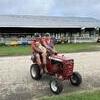
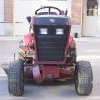
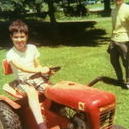


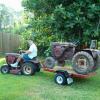
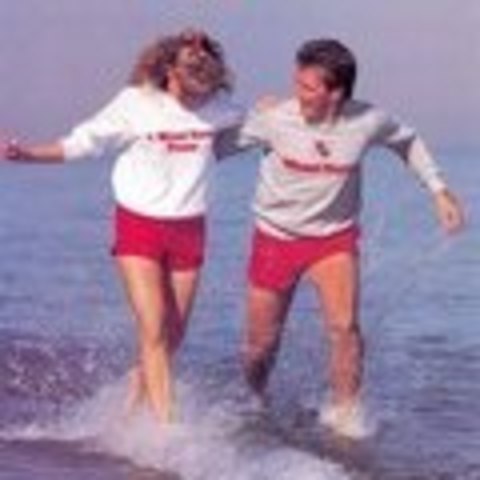

(800x673).jpg.cc3aefcd170c6bab1f22408014a1eb53.thumb.jpg.37c62115dec7a1fc65b8e86afd6af643.jpg)

